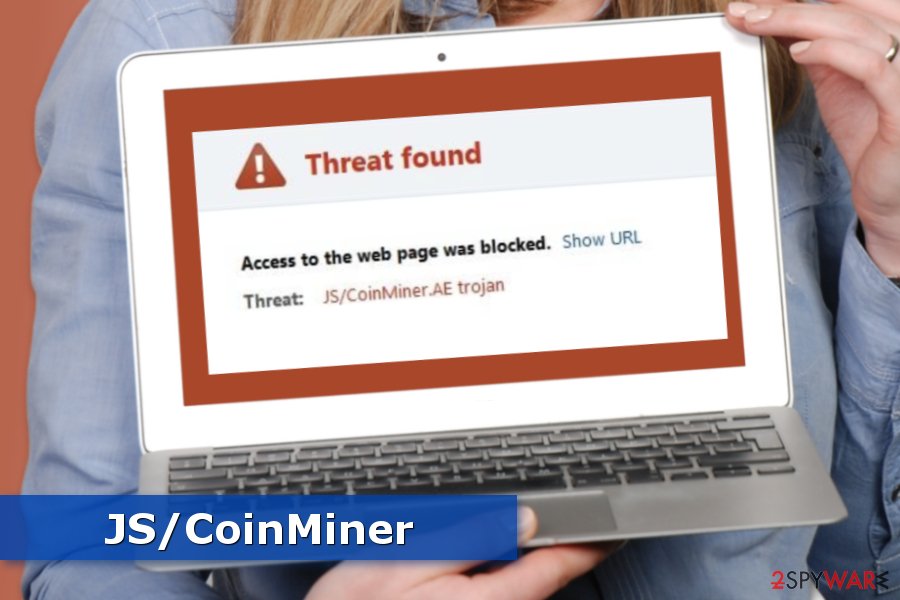JS/CoinMiner (Virus Removal Instructions) - Tutorial
JS/CoinMiner Removal Guide
What is JS/CoinMiner?
JS/CoinMiner – a cryptocurrency miner that is waiting for victims on the compromised websites

JS/CoinMiner is Trojan Horse that is being used for illegal mining cryptocurrency.[1] This dangerous cyber infection can hack websites and soon as a person visits it, malware starts mining digital currency without asking user’s permission.
The first mining scripts used by JS/CoinMiner malware was discovered in September 2017. Miner mostly targets internet users in Russia, Ukraine, and Belarus. As we have already mentioned, the virus lures on websites. Most of the affected sites were streaming video or offered to play games.
When a person visits such site, JS/CoinMiner virus immediately starts using computer’s CPU to mine Monero, Dashcoin, DarkNetCoin or other cryptocurrencies. In order to do so, creators of miner use CryptoNight Mining technique that allows hiding Coinhive JavaScript Mining code into the affected website.
The biggest problem is that users cannot notice the attack. Miner does not require downloading or installing any plugins or updates. Thus, users might not have any clue that their devices are used for illegal cryptocurrency mining.
However, it’s still possible to suspect that you are on the site that includes JS/CoinMiner because malware might reduce browsing speed, make computer sluggish or unresponsive due to the high usage of CPU. You can see the number of computer resources used in the Windows Task Manager.
When running in such conditions for a long time, your computer might overheat. Thus, it may damage your machine. Technically, JS/CoinMiner removal is impossible. However, if you found yourself on the site that drains your computer’s recourses, leave it and do not come back to it ever again.
However, if you still see your computer acting oddly, check Task Manager. You might find some suspicious processes that are draining your CPU and graphics card power. Thus, you have to stop these processes. Additionally, you have to remove JS/CoinMiner or another cryptocurrency miner from your computer immediately. For that, use FortectIntego.

Protect your self fileless malware attack
JS/CoinMiner starts its malicious activities without needing to install any programs. It might seem like a sophisticated cyber threat that is nearly impossible to avoid. However, you can still protect yourself from the miner.
First of all, you can turn off JavaScript in your browser. This will prevent malicious script from running once you access compromised website. However, this might diminish browsing experience because you be unable to access specific content on web pages.
Secondly, you can install ad-blocking program to your browser which will block malicious ads[2] that hides illegal mining scripts.
Thirdly, you can obtain a reputable antivirus which offers real-time protection, prevents from accessing malicious sites or blocks malicious codes from running.
Security specialists from virusi.hr[3] highly recommends to stay away from adult entertainment sites, shady online gaming, illegal video streaming and similar questionable websites. They are most likely to spread malicious programs.
Stop JS/CoinMiner malware from using your computer’s resources
As we have already mentioned, miner starts its malicious tasks soon as a person visits a compromised website. The currently known version of malware does not require installing any malicious components on the computer, so JS/CoinMiner removal from the device typically is not needed.
To stop miner’s activities, you have to close browser’s tab and leave a compromised website. However, if you find unknown processes in the Task Manager draining your computer’s power, you should get a reputable malware removal software (e.g. FortectIntego, Malwarebytes) and remove JS/CoinMiner with the help of it.
If this malicious program blocks access to security software, please check the instructions below. Our team will help to disable the virus and run malware removal tools.
Getting rid of JS/CoinMiner. Follow these steps
Manual removal using Safe Mode
This method can help you to disable the miner in order to run automatic elimination with security software:
Important! →
Manual removal guide might be too complicated for regular computer users. It requires advanced IT knowledge to be performed correctly (if vital system files are removed or damaged, it might result in full Windows compromise), and it also might take hours to complete. Therefore, we highly advise using the automatic method provided above instead.
Step 1. Access Safe Mode with Networking
Manual malware removal should be best performed in the Safe Mode environment.
Windows 7 / Vista / XP
- Click Start > Shutdown > Restart > OK.
- When your computer becomes active, start pressing F8 button (if that does not work, try F2, F12, Del, etc. – it all depends on your motherboard model) multiple times until you see the Advanced Boot Options window.
- Select Safe Mode with Networking from the list.

Windows 10 / Windows 8
- Right-click on Start button and select Settings.

- Scroll down to pick Update & Security.

- On the left side of the window, pick Recovery.
- Now scroll down to find Advanced Startup section.
- Click Restart now.

- Select Troubleshoot.

- Go to Advanced options.

- Select Startup Settings.

- Press Restart.
- Now press 5 or click 5) Enable Safe Mode with Networking.

Step 2. Shut down suspicious processes
Windows Task Manager is a useful tool that shows all the processes running in the background. If malware is running a process, you need to shut it down:
- Press Ctrl + Shift + Esc on your keyboard to open Windows Task Manager.
- Click on More details.

- Scroll down to Background processes section, and look for anything suspicious.
- Right-click and select Open file location.

- Go back to the process, right-click and pick End Task.

- Delete the contents of the malicious folder.
Step 3. Check program Startup
- Press Ctrl + Shift + Esc on your keyboard to open Windows Task Manager.
- Go to Startup tab.
- Right-click on the suspicious program and pick Disable.

Step 4. Delete virus files
Malware-related files can be found in various places within your computer. Here are instructions that could help you find them:
- Type in Disk Cleanup in Windows search and press Enter.

- Select the drive you want to clean (C: is your main drive by default and is likely to be the one that has malicious files in).
- Scroll through the Files to delete list and select the following:
Temporary Internet Files
Downloads
Recycle Bin
Temporary files - Pick Clean up system files.

- You can also look for other malicious files hidden in the following folders (type these entries in Windows Search and press Enter):
%AppData%
%LocalAppData%
%ProgramData%
%WinDir%
After you are finished, reboot the PC in normal mode.
Remove JS/CoinMiner using System Restore
If a previous method did not help, follow these steps:
-
Step 1: Reboot your computer to Safe Mode with Command Prompt
Windows 7 / Vista / XP- Click Start → Shutdown → Restart → OK.
- When your computer becomes active, start pressing F8 multiple times until you see the Advanced Boot Options window.
-
Select Command Prompt from the list

Windows 10 / Windows 8- Press the Power button at the Windows login screen. Now press and hold Shift, which is on your keyboard, and click Restart..
- Now select Troubleshoot → Advanced options → Startup Settings and finally press Restart.
-
Once your computer becomes active, select Enable Safe Mode with Command Prompt in Startup Settings window.

-
Step 2: Restore your system files and settings
-
Once the Command Prompt window shows up, enter cd restore and click Enter.

-
Now type rstrui.exe and press Enter again..

-
When a new window shows up, click Next and select your restore point that is prior the infiltration of JS/CoinMiner. After doing that, click Next.


-
Now click Yes to start system restore.

-
Once the Command Prompt window shows up, enter cd restore and click Enter.
Finally, you should always think about the protection of crypto-ransomwares. In order to protect your computer from JS/CoinMiner and other ransomwares, use a reputable anti-spyware, such as FortectIntego, SpyHunter 5Combo Cleaner or Malwarebytes
How to prevent from getting malware
Protect your privacy – employ a VPN
There are several ways how to make your online time more private – you can access an incognito tab. However, there is no secret that even in this mode, you are tracked for advertising purposes. There is a way to add an extra layer of protection and create a completely anonymous web browsing practice with the help of Private Internet Access VPN. This software reroutes traffic through different servers, thus leaving your IP address and geolocation in disguise. Besides, it is based on a strict no-log policy, meaning that no data will be recorded, leaked, and available for both first and third parties. The combination of a secure web browser and Private Internet Access VPN will let you browse the Internet without a feeling of being spied or targeted by criminals.
No backups? No problem. Use a data recovery tool
If you wonder how data loss can occur, you should not look any further for answers – human errors, malware attacks, hardware failures, power cuts, natural disasters, or even simple negligence. In some cases, lost files are extremely important, and many straight out panic when such an unfortunate course of events happen. Due to this, you should always ensure that you prepare proper data backups on a regular basis.
If you were caught by surprise and did not have any backups to restore your files from, not everything is lost. Data Recovery Pro is one of the leading file recovery solutions you can find on the market – it is likely to restore even lost emails or data located on an external device.
- ^ Thomas Fox-Brewster. One Hacker Can Make $100M A Year With Evil Cryptocurrency Miners. Forbes. Business, investing, technology, entrepreneurship, leadership, and lifestyle news.
- ^ Adam Rosenberg. YouTube ads are the latest ground zero for nefarious crypto mining. Mashable. Tech, business and entertainment news.
- ^ Virusi. Virusi. Croatian cyber security news.





















